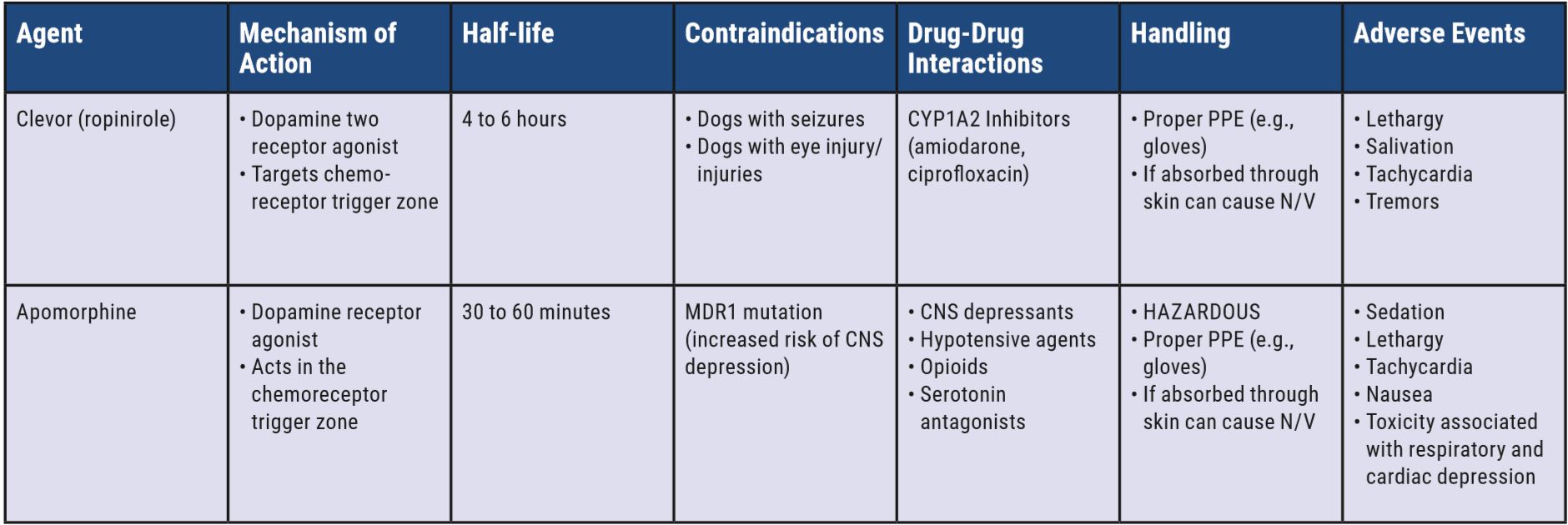In certain situations, inducing emesis in dogs may be required. A flow chart has been developed by veterinarians from Auburn University indicating when it is and is not appropriate to induce emesis. The authors do not recommend inducing emesis when:
- The dog has ingested substances that contain hydrocarbons or petroleum distillates, corrosive substances, or sharp objects;
- The dog has underlying medical conditions, such as upper airway disease;
- The dog has already vomited.
In the above situations, emesis may further damage organs and/or worsen the condition of the animal.
Inducing emesis is appropriate when the patient’s mentation is appropriate, the patient can protect the airway and it is less than 2 hours since the time of ingestion. If more than 2 hours has elapsed since ingestion, the authors recommend performing an ultrasound to determine appropriate treatment.
Medication Overview
Clevor (ropinirole) and apomorphine can be used in dogs when the induction of emesis is both required and appropriate. Clevor is an FDA-approved ophthalmic formulation to induce emesis in dogs that are 4.5 months and older and have a minimum weight of 1.8 kg.
Apomorphine has no FDA approval in the US for emesis in dogs but has extra-label dosing for inducing emesis in dogs. It can be given intravenously (IV), subcutaneously (SC), intramuscularly (IM), subconjunctival, or orally.
Safety
Though both Clevor and apomorphine are dopamine agonists, they have many differences. Clevor is FDA-approved and therefore has more specific requirements for use, including an age restriction, whereas apomorphine is being used extra-label and does not currently have any age restrictions.
Apomorphine may reach a higher concentration in dogs with hepatic impairment. Therefore, caution should be taken in dogs with liver disease. The handling of Clevor and apomorphine in humans can produce unwanted side effects, but the greater concern with administration is that apomorphine is a hazardous drug.
Clevor is available as an eye drop, while apomorphine must be compounded from the bulk drug powder. When comparing time to emesis, Clevor is 12 minutes and apomorphine IV is 1-5 minutes, SC is 13 minutes, IM is >15 minutes, subconjunctival is within 15 minutes, and oral is 4-6 minutes.
Apomorphine has more serious side effects, such as CNS and respiratory depression, while Clevor appears to be more tolerable. However, because the approval for Clevor is based on age and weight requirements, there may be adverse effects in patients outside those requirements.
When your patient fits the age and weight requirements for the use of Clevor and there are no administration concerns, such as current ophthalmic disease or anophthalmia, Clevor has been deemed a comparatively “safer” option for both the staff and patient.
Article references are available by visiting: vetmed.illinois.edu/veterinarians/
Kylie Kelley was a pharmacy intern in our hospital.
References
- Kendon Kuo, DVM, MS, DACVECC Katherine Gerken, DVM, MS, DACVECC. EMESIS INDUCTION. Accessed June 16, 2022. https://app-plumbs-com.proxy2.library.illinois.edu/api/v1/contents/pdf/NGY4NWJlOGItYTRkZC00MDQ3LWFhODAtY2UxNGI5ZjhiMWU0/bvEVPsLLQuj39Rz4qofpy.pdf
- Ropinirole. Plumb’s Veterinary Drugs. Accessed June 16, 2022. https://app-plumbs-com.proxy2.library.illinois.edu/drug-monograph/1VSUrGkcww7JIw121bjLqA?source=search&searchQuery=clevor
- Apomorphine. Plumb’s Veterinary Drugs. Accessed June 16, 2022. https://app-plumbs-com.proxy2.library.illinois.edu/drug-monograph/9113HOC31WPROD?source=search&searchQuery=apo
- Rewane A, Nagalli S. Ropinirole. [Updated 2022 May 15]. In: StatPearls [Internet]. Treasure Island (FL): StatPearls Publishing; 2022 Jan-. Available from: https://www.ncbi.nlm.nih.gov/books/NBK554532/
By Kylie Kelley




